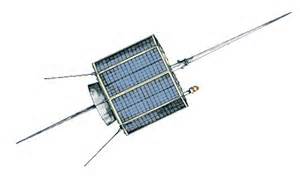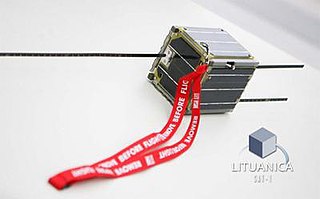
Radioteletype (RTTY) is a telecommunications system consisting originally of two or more electromechanical teleprinters in different locations connected by radio rather than a wired link. Radioteletype evolved from earlier landline teleprinter operations that began in the mid-1800s. The US Navy Department successfully tested printing telegraphy between an airplane and ground radio station in 1922. Later that year, the Radio Corporation of America successfully tested printing telegraphy via their Chatham, Massachusetts, radio station to the R.M.S. Majestic. Commercial RTTY systems were in active service between San Francisco and Honolulu as early as April 1932 and between San Francisco and New York City by 1934. The US military used radioteletype in the 1930s and expanded this usage during World War II. From the 1980s, teleprinters were replaced by personal computers (PCs) running software to emulate teleprinters.
AMSAT is a name for various amateur radio satellite organizations worldwide. In particular, it often refers to the Radio Amateur Satellite Corporation, headquartered in Washington, D.C. AMSAT organizations design, build, arrange launches for, and then operate (command) satellites carrying amateur radio payloads, including the OSCAR series of satellites. Other informally affiliated national organizations exist, such as AMSAT Germany (AMSAT-DL) and AMSAT Japan (JAMSAT).
UoSAT-2, which is also known as UO-11 and OSCAR-11, is a British satellite orbiting in Low Earth Orbit. The satellite functions as an amateur radio transmitter and was built at the University of Surrey. It launched into orbit in March 1984 and remains orbital and active, though unstable with irregular periods of transmission. All of the analogue telemetry channels failed in 2005, but as of 2014 the status channels were still operational. The satellite was still heard transmitting telemetry in 2023, thirty-nine years after launch.

AMSAT-OSCAR 51 or AO-51 is the in-orbit name designation of a now defunct LEO amateur radio satellite of the OSCAR series; formerly known as ECHO, built by AMSAT. It was launched on June 29, 2004 from Baikonur Cosmodrome, Kazakhstan on a Dnepr launch vehicle. It is in Sun synchronous low Earth orbit.
HAMSAT also known as HAMSAT INDIA, VU2SAT and VO-52 is a microsatellite weighing 42.5 kilograms (93.7 lb), providing amateur radio satellite communications services for Indian and international amateur radio operators. This satellite carries the in-orbit designation of VO-52, and is an OSCAR series satellite.
The 10-meter band is a portion of the shortwave radio spectrum internationally allocated to amateur radio and amateur satellite use on a primary basis. The band consists of frequencies stretching from 28.000 to 29.700 MHz.
Q15X25 is a communications protocol for sending data over a radio link. It was designed by amateur radio operator Pawel Jalocha, SP9VRC, to be an open communications standard. Like all amateur radio communications modes, this protocol uses open transmissions which can be received and decoded by anyone with similar equipment. Q15X25 is a form of packet radio. It can be used to interconnect local VHF AX.25 packet networks over transcontinental distances. Anyone can design or adapt the open-source software to develop their own Q15X25 system.

Radio is the technology of communicating using radio waves. Radio waves are electromagnetic waves of frequency between 3 hertz (Hz) and 300 gigahertz (GHz). They are generated by an electronic device called a transmitter connected to an antenna which radiates oscillating electrical energy, often characterized as a wave. They can be received by other antennas connected to a radio receiver, this is the fundamental principle of radio communication. In addition to communication, radio is used for radar, radio navigation, remote control, remote sensing, and other applications.

AMSAT-OSCAR 7, or AO-7, is the second Phase 2 amateur radio satellite constructed by the Radio Amateur Satellite Corporation (AMSAT). It was launched into Low Earth Orbit on November 15, 1974 and remained operational until a battery failure in 1981. After 21 years of apparent silence, the satellite was heard again on June 21, 2002 – 27 years after launch. At that time the public learned that the satellite had remained intermittently functional and was used surreptitiously for communication by the anticommunist opposition Fighting Solidarity during martial law in Poland.
SSETI Express was the first spacecraft to be designed and built by European students and was launched by the European Space Agency. SSETI Express is a small spacecraft, similar in size and shape to a washing machine. On board the student-built spacecraft were three CubeSat picosatellites, extremely small satellites weighing around one kg each. These were deployed one hour and forty minutes after launch. Twenty-one university groups, working from locations spread across Europe and with very different cultural backgrounds, worked together via the internet to jointly create the satellite. The expected lifetime of the mission was planned to be 2 months. SSETI Express encountered an unusually fast mission development: less than 18 months from kick-off in January 2004 to flight-readiness.

The Unified S-band (USB) system is a tracking and communication system developed for the Apollo program by NASA and the Jet Propulsion Laboratory (JPL). It operated in the S band portion of the microwave spectrum, unifying voice communications, television, telemetry, command, tracking and ranging into a single system to save size and weight and simplify operations. The USB ground network was managed by the Goddard Space Flight Center (GSFC). Commercial contractors included Collins Radio, Blaw-Knox, Motorola and Energy Systems.
An amateur radio satellite is an artificial satellite built and used by amateur radio operators. It forms part of the Amateur-satellite service. These satellites use amateur radio frequency allocations to facilitate communication between amateur radio stations.
Australis-OSCAR 5 is an amateur radio satellite that was launched into Low Earth Orbit on 23 January 1970 by a Thor Delta launcher from Vandenberg Air Force Base, Lompoc, California. AO-5 was launched piggyback with TIROS-M (ITOS-1) weather satellite).

OSCAR IV was the fourth amateur radio satellite launched by Project OSCAR and the first targeted for Geostationary orbit on 12 December 1965. The satellite was launched piggyback with three United States Air Force satellites on a Titan IIIC launch vehicle. Due to a booster failure, OSCAR 4 was placed in an unplanned and largely unusable Geostationary transfer orbit.

LituanicaSAT-1 was one of the first two Lithuanian satellites. It was launched along with the second Cygnus spacecraft and 28 Flock-1 CubeSats aboard an Antares 120 carrier rocket flying from Pad 0B at the Mid-Atlantic Regional Spaceport on Wallops Island to the International Space Station. The launch was scheduled to occur in December 2013, but later was rescheduled to 9 January 2014 and occurred then. The satellite was broadcasting greetings of Lithuanian president, Mrs. Dalia Grybauskaitė. The satellite was deployed from the International Space Station via the NanoRacks CubeSat Deployer on 28 February 2014. All LituanicaSAT-1 subsystems have been turned on, tested and proved to be working properly. The mission is considered a complete success by its team of engineers. The mission ended upon the reentry and disintegration of the satellite on 28 July 2014.

FUNcube-1 is a complete educational single unit CubeSat satellite with the goal of enthusing and educating young people about radio, space, physics and electronics. It is part of a program which aims to launch more of these educational CubeSats. It is the first satellite with outreach as its primary mission.

Es'hail 2 is a Qatari satellite, launched aboard a SpaceX Falcon 9 rocket on November 15, 2018. Es'hail 2 was built by Japan's Mitsubishi Electric company, and operates at 26° East longitude along a geostationary orbit to provide direct-to-home television services in the Middle East and North Africa region. The satellite features 24 Ku-band and 11 Ka-band transponders to provide direct broadcasting services for television, government and commercial content distribution. In addition to commercial services, the payload of Es'hail 2 includes a linear transponder with a bandwidth of 500 kHz and 8 MHz for the amateur radio satellite service, with uplink on 2.4 GHz and downlink on 10.45 GHz.
ParkinsonSAT, PSat or Naval Academy OSCAR 84 is a U.S. technology demonstration satellite and an amateur radio satellite for Packet Radio. It was built at the U.S. Naval Academy and was planned as a double satellite. The name ParkinsonSAT was chosen in honor of Bradford Parkinson, the father of the GPS system. After successful launch, the satellite was assigned the OSCAR number 84.
OSCAR 8 is an American amateur radio satellite. It was developed and built by radio amateurs of the AMSAT and launched on March 5, 1978 as a secondary payload together with the Earth observation satellite Landsat 3 from Vandenberg Air Force Base, California, United States.
Weber-OSCAR 18 is an American amateur radio satellite.








